Category Archives: Cuckoo
Big baby! Koel cuckoo fed by Red Wattlebird
It’s cuckoo season here on the east coast of Australia. We have several types of cuckoos that migrate to our shores for the summer months and get the local birds to feed their young. That’s right! Cuckoos lay their eggs in some other bird’s nest and fly away free as a … well, as a bird. The adoptive parent is often much smaller than the baby cuckoo, but it’s hornswoggled into feeding the youngster until the cuckoo is old enough to take care of itself.
One of the cuckoos that come to our shores is the Common Koel, also called the Eastern Koel. A couple of days ago, I saw a young Koel being fed by a Red Wattlebird:
In the video, you can hear the juvenile Koel chirping repeatedly, begging for food.
Here’s a photo of the big baby:

Adult Koels make quite a variety of sounds, including loud squawks and more melodic whistles. You can hear them in the video in this post. And you can see some shots of male and female adult Koels in other posts.
Common name: Common Koel, Pacific Koel, or Eastern Koel
Scientific name: Eudynamys orientalis (was scolopacea)
Approximate length: 45 cm
Date spotted: 3 December 2025 (summer)
Location: Manly Dam Park, New South Wales, Australia: 33°46’57.5″S 151°15’20.8″E
Two songs of the Fan-tailed Cuckoo
I’ve heard Fan-tailed Cuckoos several times over the years, making their pretty downward trilling call. A few days ago, I heard a different call: a haunting, mournful whistle sighing in the mist.
In this 14-second video, the bird whistles five times:
At first I didn’t know what type of bird was calling. Then I saw a Fan-tailed Cuckoo fly onto a nearby branch:

They’re rather pretty birds, with a russet chest and belly, and a startling orange mouth. On this occasion, I could see only the back of the bird. Here’s a picture of another Fan-tailed Cuckoo, which I saw in June 2020:
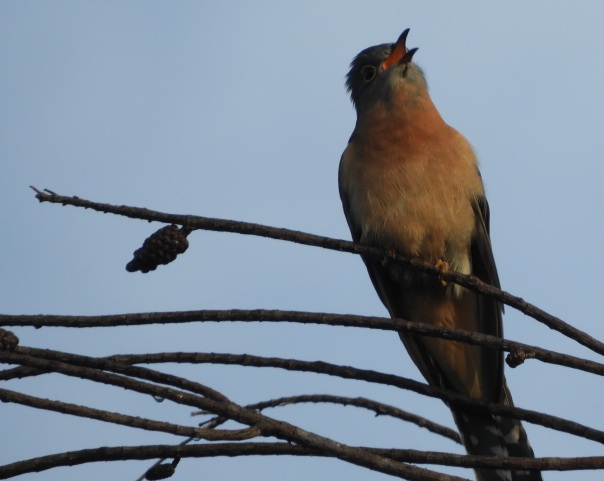
Shortly after I heard the whistles, the same bird or another started making the typical trilling call that I’ve heard more often. In this 17-second video, the bird calls four times:
Common name: Fan-tailed Cuckoo
Scientific name: Cacomantis flabelliformis
Approximate length: 26 cm
Date spotted: 11 May 2025 (autumn)
Location: Manly Creek, New South Wales, Australia: 33°46’21.3″S 151°14’34.8″E
Those dinosaur birds are back for the summer: Channel-billed Cuckoos
Channel-billed Cuckoos are large, strange-looking birds with red eyes, a large canoe-shaped beak, and a strangely apologetic way of moving around. These cuckoos migrate to Australia’s south-eastern coast in the warmer months, and they’ve just arrived for this year’s summer.

When provoked, Channel-billed Cuckoo’s make a reptilian hissing noise. With their red eyes and fierce beaks, and the prehistoric way that they move, they remind me that their ancestors were dinosaurs.

Like many other cuckoos, these birds lay their eggs in the nests of other birds, such as Currawongs, and leave the raising of their chicks to the adoptive parents.
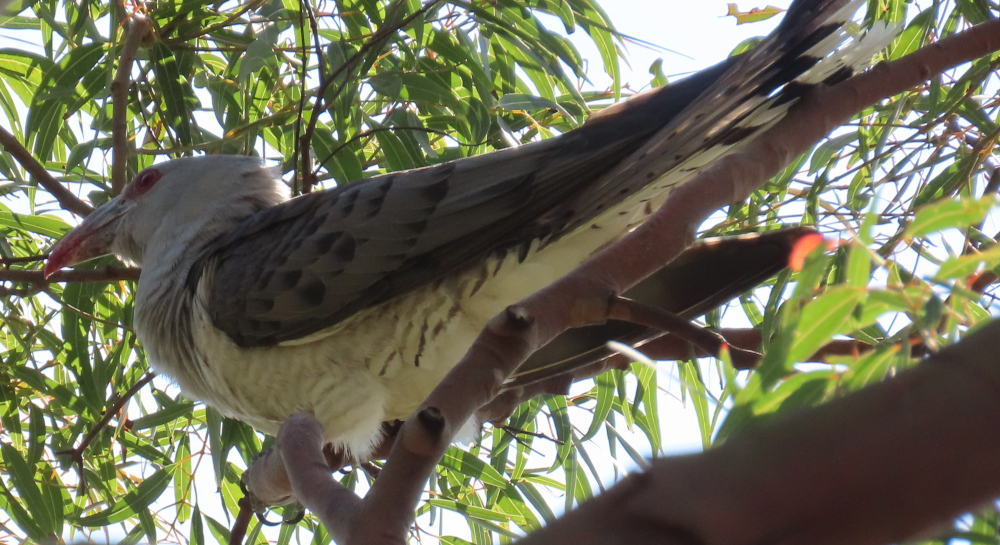
A Channel-billed Cuckoo’s life is not a peaceful one. Several other species do their best to chase the cuckoos out of the neighbourhood, to prevent them from hi-jacking nests. In this video, the cuckoo ducks the persistent swooping of Noisy Miners (hint: set the video quality to high definition for best viewing):
You can find out more about these birds in my other posts about cuckoos.
Common name: Channel-billed Cuckoo
Scientific name: Scythrops novaehollandiae
Approximate length: 58-65 cm
Date spotted: 22 September 2024 (spring)
Location: Allambie Heights, New South Wales, Australia
Koel cuckoo wearing the midnight
The Koel cuckoos are back! They migrate to our region of eastern Australia in spring, and go back up north in autumn. You know they’re there because of their loud call: coo-eee, coo-ee. It’s less often that you manage to see one, as they tend to stay high up in the trees and make use of the foliage to hide from other birds.
This male Koel spent a few minutes in a relatively exposed position on the street where I live:
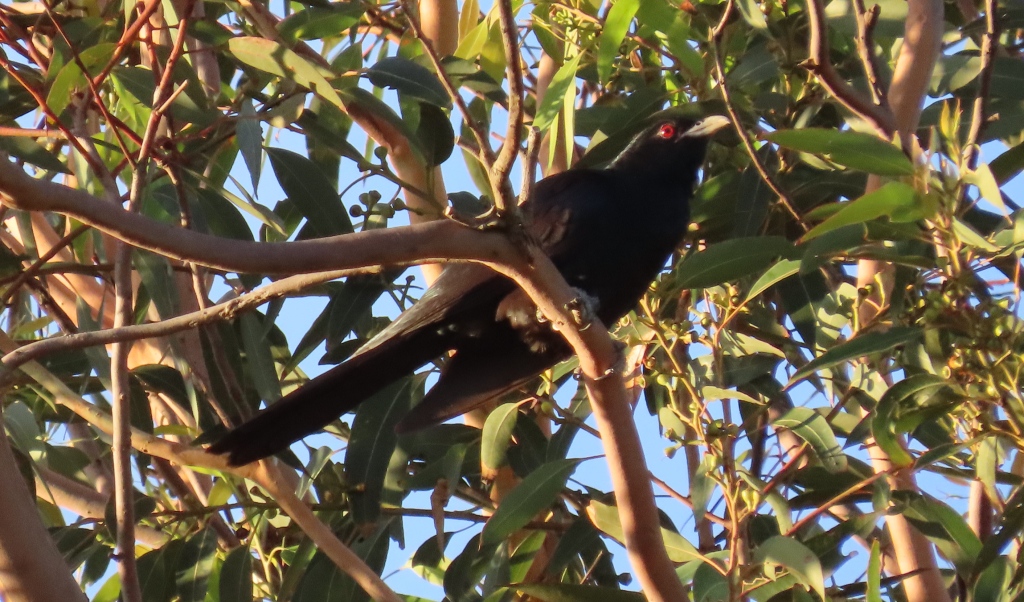
The males are entirely black, with bright red eyes and a pale beak. Like other cuckoos, the females lay their eggs in the nests of other birds (mostly wattle birds and friar birds). The cuckoo then abandons the egg and leaves it up to the foster parents to bring up the chick.
My earlier posts name this bird as a Common Koel (Eudynamys scolopacea). I’ve discovered recently that Koel cuckoos were recently reclassified as Pacific Koels (Eudynamys orientalis).
Common name: Pacific Koel or Eastern Koel
Scientific name: Eudynamys orientalis (was scolopacea)
Approximate length: 45 cm
Date spotted: 19 January 2024 (summer)
Location: Allambie Heights (north of Sydney) New South Wales, Australia
Young Channel-billed Cuckoos fed by currawongs
What’s that caterwauling? It’s a couple of young Channel-billed Cuckoos, awaiting their food. Are the patient bringers of food the parents of the young birds? No, they’re Pied Currawongs. Because, like other parasitic cuckoos, Channel-billed Cuckoos lay their eggs in the nests of other birds and leave it entirely to the adoptive parents to care for the youngsters.
The other ongoing noise that you hear in this video are the Cicadas. It’s the season of noisy beetles and noisy birds!
This is the second time that I’ve seen two young cuckoos being fed by currawongs, instead of just one. Evidently it’s quite common for these birds to lay more than one egg in someone else’s nest.
Here’s a still photo of the young cuckoo. What a big baby. It’s far larger than the currawongs that are taking care of it.

Here’s the youngster flapping its wings to make sure its carers don’t miss it:
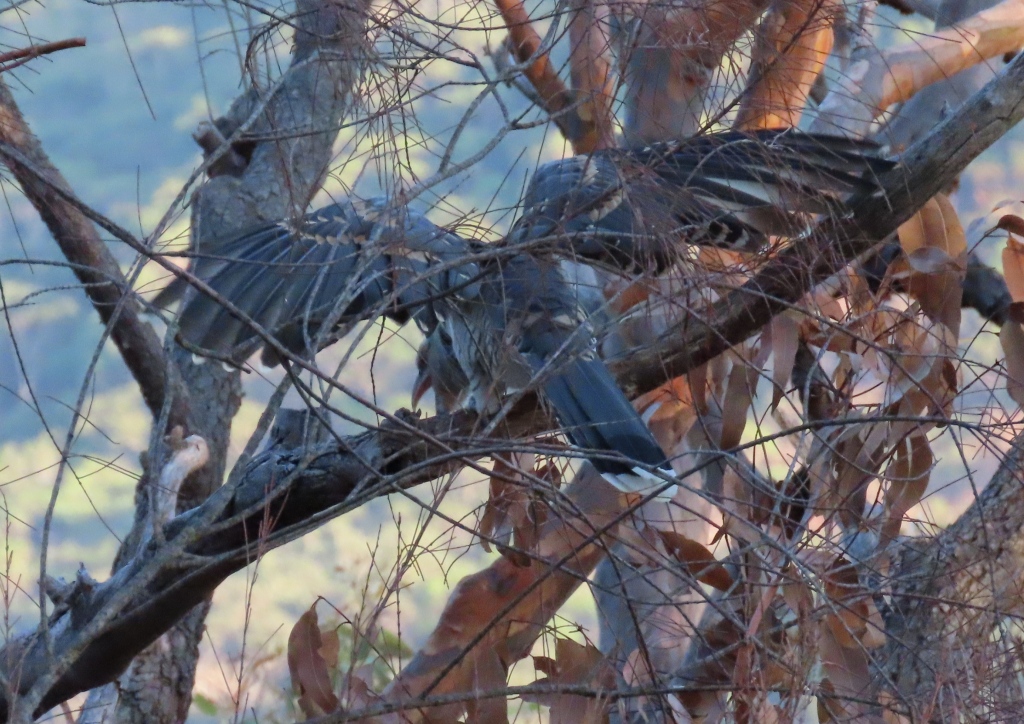
Channel-billed Cuckoo | Scythrops novaehollandiae | Approximate length: 58-65 cm
Pied Currawong | Strepera graculina | Approximate length: 45 cm
Date spotted: 28 December 2022 (summer)
Location: Manly Dam Park, New South Wales, Australia: 33°46’50.1″S 151°14’59.6″E
Channel-billed Cuckoo at Mount Annan
Today I went for a stroll at the Australian Botanic Garden in Mount Annan, to the south west of Sydney. It’s a good place for a walk, with well-maintained pathways and beautifully laid-out gardens.
This Channel-billed Cuckoo sat high on a bare tree branch, basking in the morning sun:

Channel-billed Cuckoos are large, imposing birds. I often think they look a bit creepy, with their red eyes and huge curved beaks. They’re migratory, coming down to the south east coast of Australia during the summer months. I heard the first arrivals of the season just a couple of weeks ago.
You can find out more about these birds in my other posts about cuckoos.
Common name: Channel-billed Cuckoo
Scientific name: Scythrops novaehollandiae
Approximate length: 58-65 cm
Date spotted: 16 October 2022 (spring)
Location: Mount Annan, New South Wales, Australia: 34°04’29.9″S 150°45’48.5″E
Baby Channel-billed Cuckoos fed by Currawongs
Walking along a shady path this morning, I heard a loud caterwauling from above. Two baby Channel-billed Cuckoos sat in the trees, yowling and shaking their wings. A Currawong arrived and fed a piece of meat to one of the cuckoos. Then another Currawong brought food to the second screeching youngster.
Like most cuckoos, Channel-billed Cuckoos lay their eggs in the nests of other birds and leave it to those other birds to hatch the egg and look after the growing chick. These particular cuckoos are very large (around 65 cm from head to tail) and so they need to pick the adoptive parents carefully. Currawongs are the usual choice.
This video shows one of the babies yowling and begging for food from its Currawong adoptive parent:
See how large the baby is in relation to the Currawong who’s looking after it! In the next video, one of the babies attempts to eat a largish morsel of meat that a Currawong has just fed to it:
I’ve never seen two babies together before. I wonder if they both came from the same nest, or if they found each other after leaving their nests?
Here’s a still picture of one of the baby cuckoos:
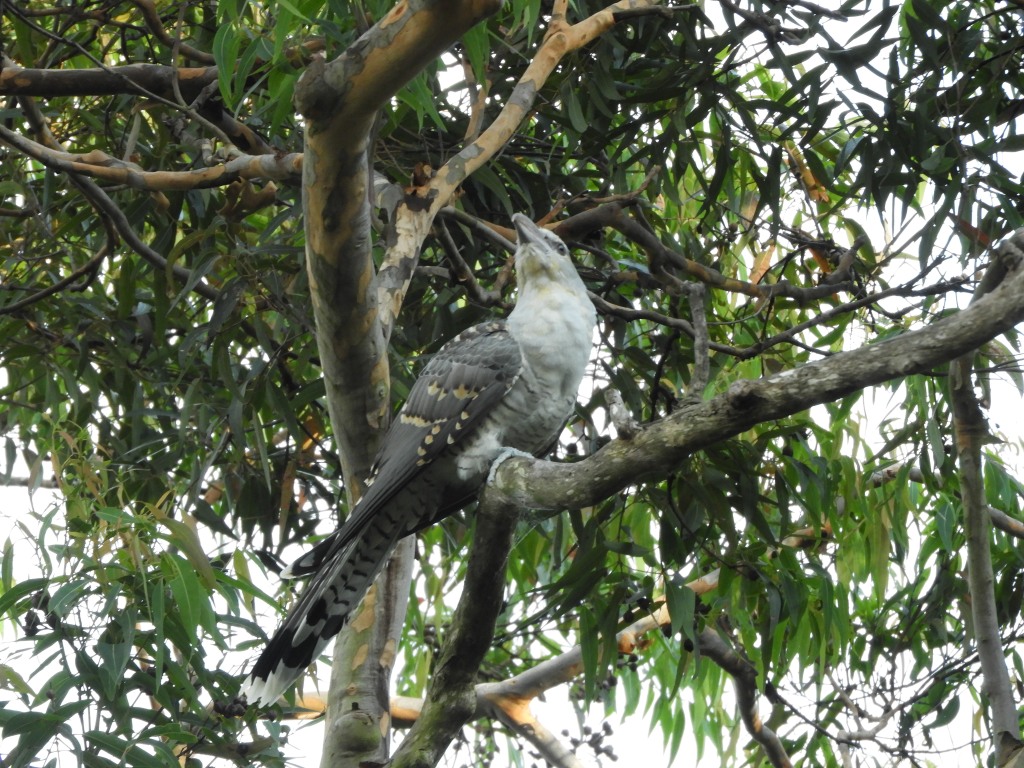
Being a youngster, its eyes are still light brown. The adult birds have fierce red eyes. They’re magnificently ugly birds.
In the next picture, one of the babies is pointing its beak at the sky, perhaps wondering where its next feed is coming from:
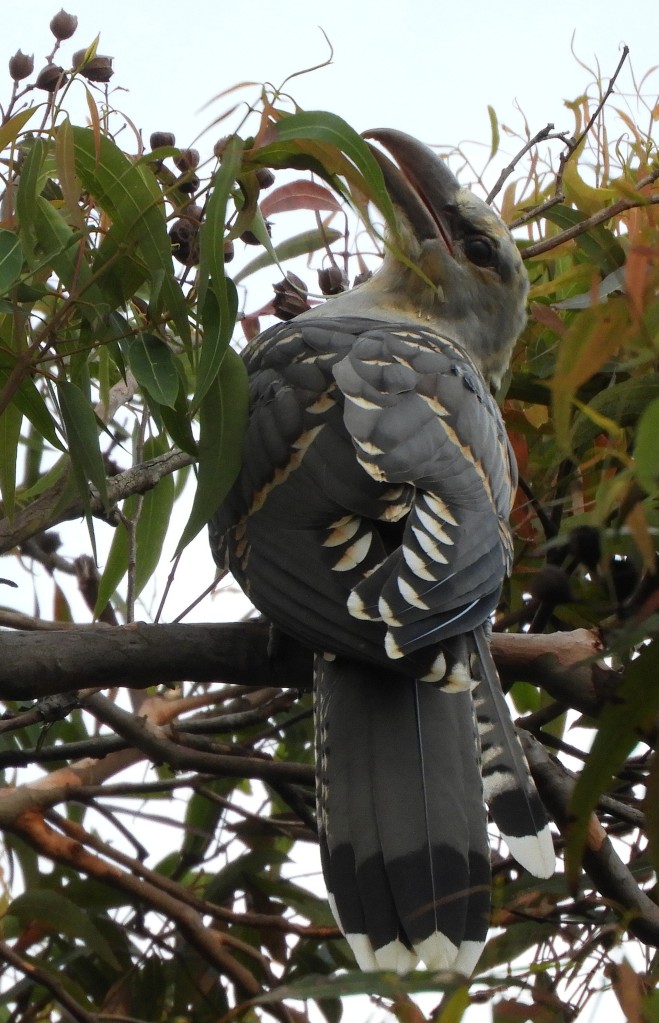
That picture gives a good view of the bird’s large beak and the markings on its back and tail.
One of the things you notice about Channel-billed Cuckoos is the supple way they move their neck and head. Here’s one of the babies leaning forward, in a pose that’s typical of these birds:
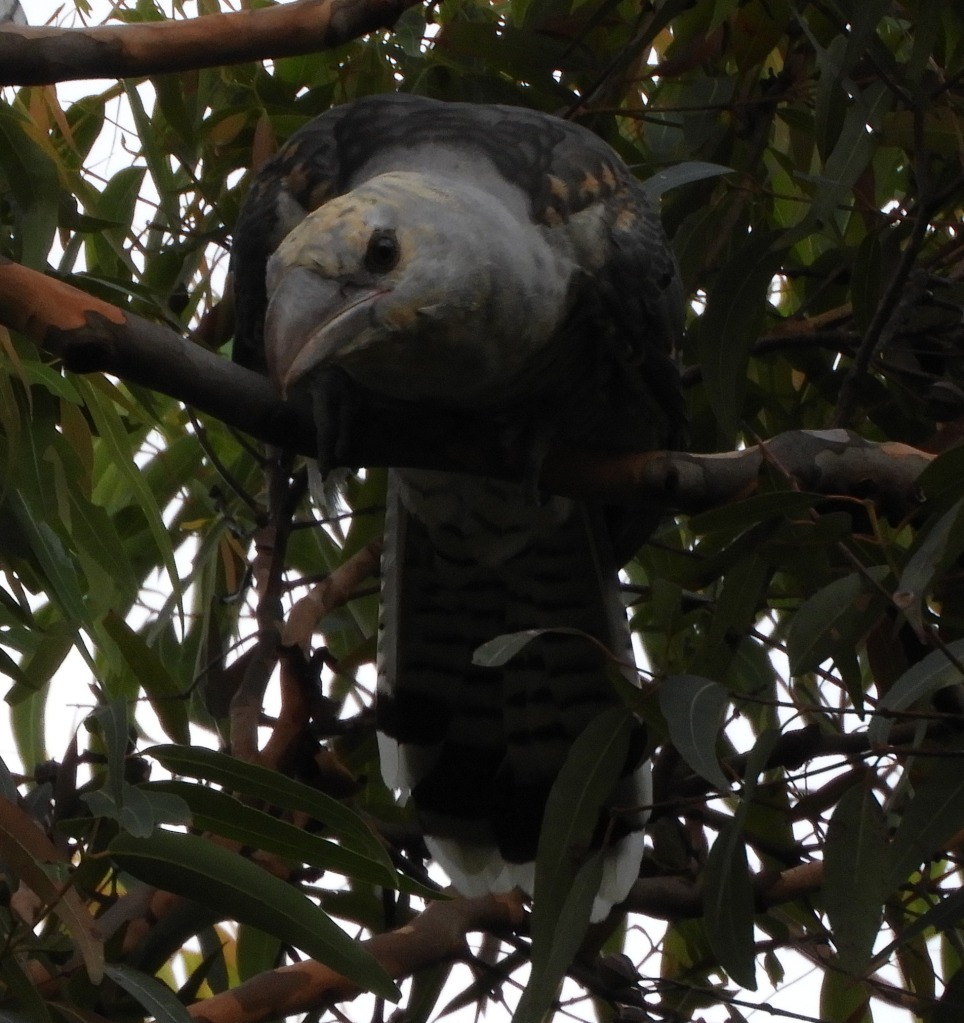
Oo-er, you probably wouldn’t want to bump into that bird one dark night. Here’s a picture of both baby cuckoos, looking at each other:

To finish off with, here’s a close up of one of the babies, head and neck only:

You can find out more about these birds in my other posts about cuckoos.
Common name: Channel-billed Cuckoo
Scientific name: Scythrops novaehollandiae
Approximate length: 58-65 cm
Date spotted: 18 December 2021 (summer)
Location: Manly-to-Spit Walk, Balgowlah, New South Wales, Australia: 33°48’00.9″S 151°15’54.9″E
Channel-billed Cuckoo laying egg in Currawong nest
This little episode happened in my garden today. It was interesting and exciting to watch!
A cacophany of Noisy Miners and Currawongs drew me out into the garden to see what was up. High in a gum tree were two Channel-billed Cuckoos, being harassed as usual by the other birds. I only managed to get one of the cuckoos into my camera sights. Luckily, it turned out to be the female bird.
Here’s the Channel-billed Cuckoo on the right, with a little Noisy Miner by its side:
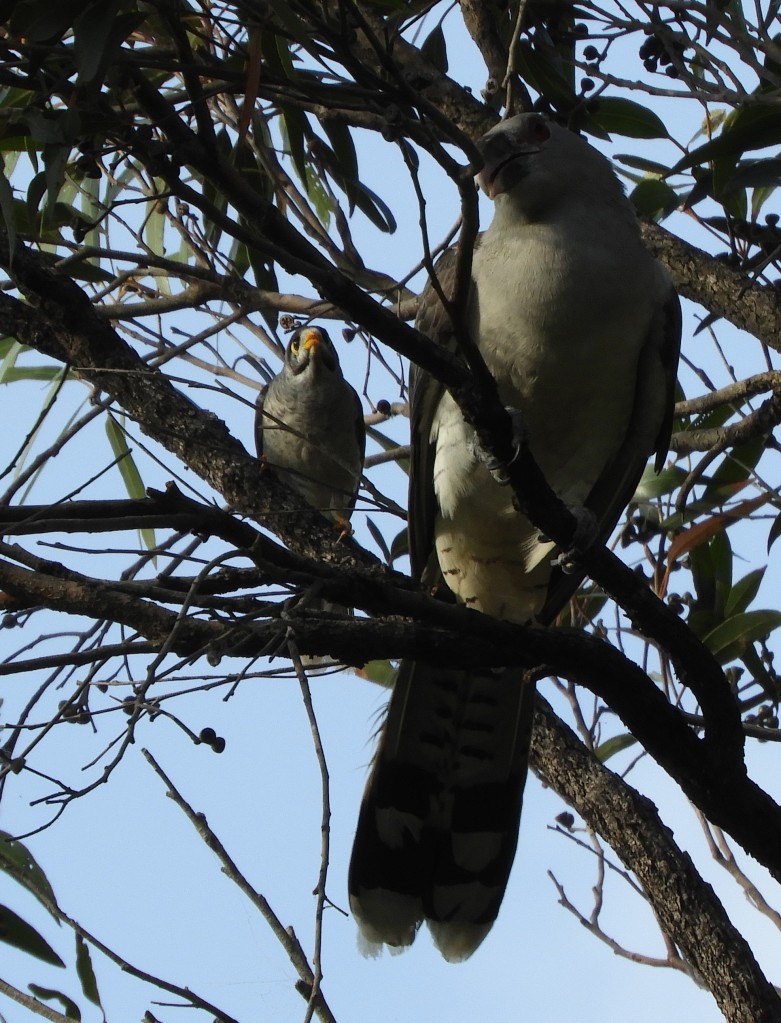
In this short video, you can hear the Noisy Miners peeping incessantly. The cuckoo emits a loud, harsh caw and cedes ground:
Next, the local Currawongs join the attack. The musical, bell-like tones are the Currawongs. The cuckoo flinches and utters its harsh croak. Then I noticed that there’s a Currawong nest just below where the cuckoo is sitting!
Like most cuckoos, Channel-billed Cuckoos are parasitic. They don’t build nests of their own. Instead, they look for a likely host (a Currawong does very nicely, thank you) and lay an egg in the chosen host’s nest. The Currawongs take over all parental duties, looking after the egg along with those of their own, then feeding the baby bird.
Channel-billed Cuckoo chicks don’t turf the other chicks out of the nest (many types of cuckoo chicks do) but they do eat a lot, and grow significantly bigger than the Currawong chicks.
Having decided that the neighbourhood is reasonably quiet and safe for a bit, the cuckoo eyes the nest and starts its approach:
Quick as a flash, it hops up into the nest and lays its egg:
Below is a still picture of the Currawong’s nest. I’ll keep an eye on it, in case I can spot the Currawong and cuckoo chicks when they arrive:

Channel-billed Cuckoo | Scythrops novaehollandiae | Approximate length: 58-65 cm
Noisy Miner, also called Australian Miner | Manorina melanocephala | Approximate length: 26 cm
Pied Currawong | Strepera graculina | Approximate length: 45 cm
Date spotted: 10 October 2021 (spring)
Location: Allambie Heights, New South Wales, Australia
First Channel-billed Cuckoo of the season
It’s spring down under, and the cuckoos are back on the east coast of Australia. Last week I heard the calls of Koel Cuckoos and Channel-billed Cuckoos. Now I’ve seen my first one of the season: A Channel-billed Cuckoo sheltering from the local birds in a gum tree.
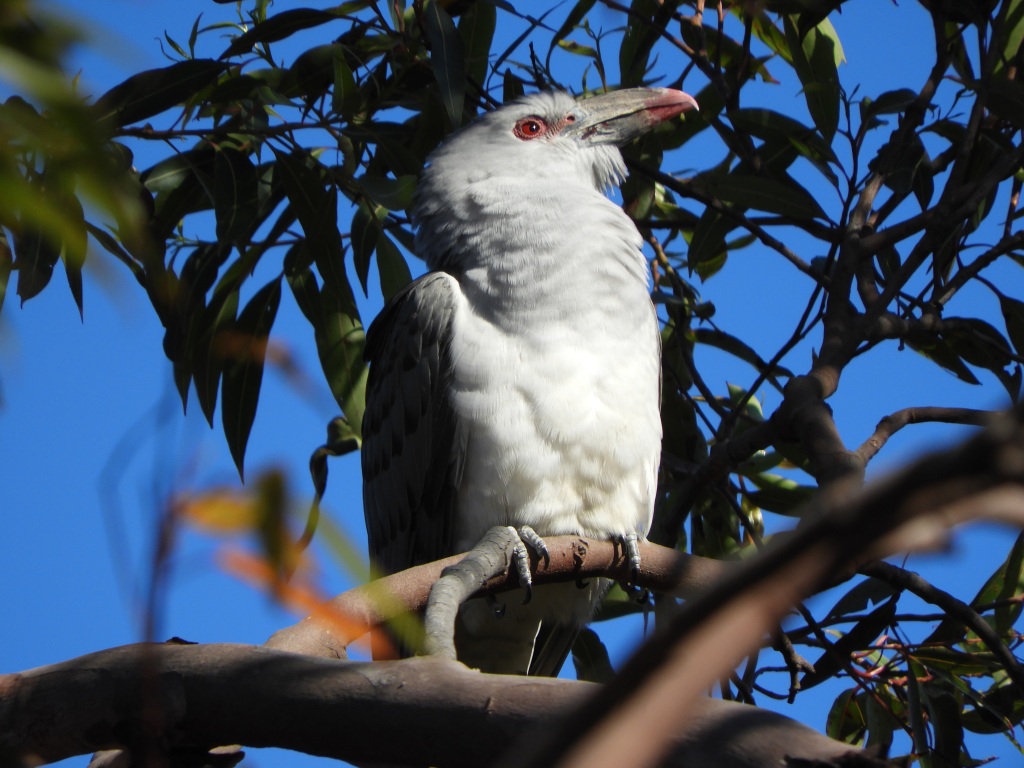
Channel-billed Cuckoos are large birds (approximately 60 cm long) with red eyes and a big beak. They often look a little scruffy, even ghoulish. The other birds seem to think so too, because they spend a lot of time dive-bombing the cuckoos and shouting at them. Usually the Noisy Miners (living up to their name) are the noisiest of the birds that strive to make the cuckoos feel unwelcome, but other birds play their part too.
This video shows the cuckoo enjoying the peace and quiet of a gum tree. At the start of the video, a Currawong swoops past in a threatening flyby. You don’t actually see the Currawong, but you can hear it and see the cuckoo flinch:
Here’s a photo showing the full length of the cuckoo, including its long, barred tail:
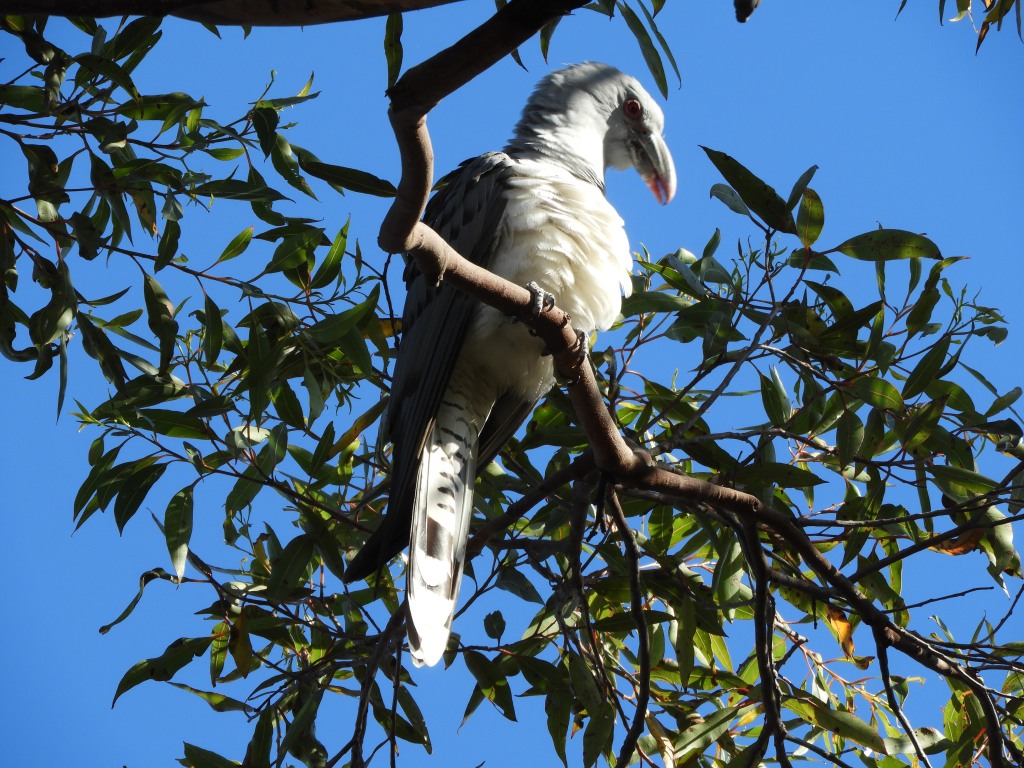
Here’s a view from the back:

Common name: Channel-billed Cuckoo
Scientific name: Scythrops novaehollandiae
Approximate length: 58-65 cm
Date spotted: 19 September 2021 (spring)
Location: Manly Dam Park, New South Wales, Australia: 33°46’33.8″S 151°15’17.8″E
A bonus bird: Just after the Channel-billed Cuckoo flew off, a kookaburra landed on a nearby branch:
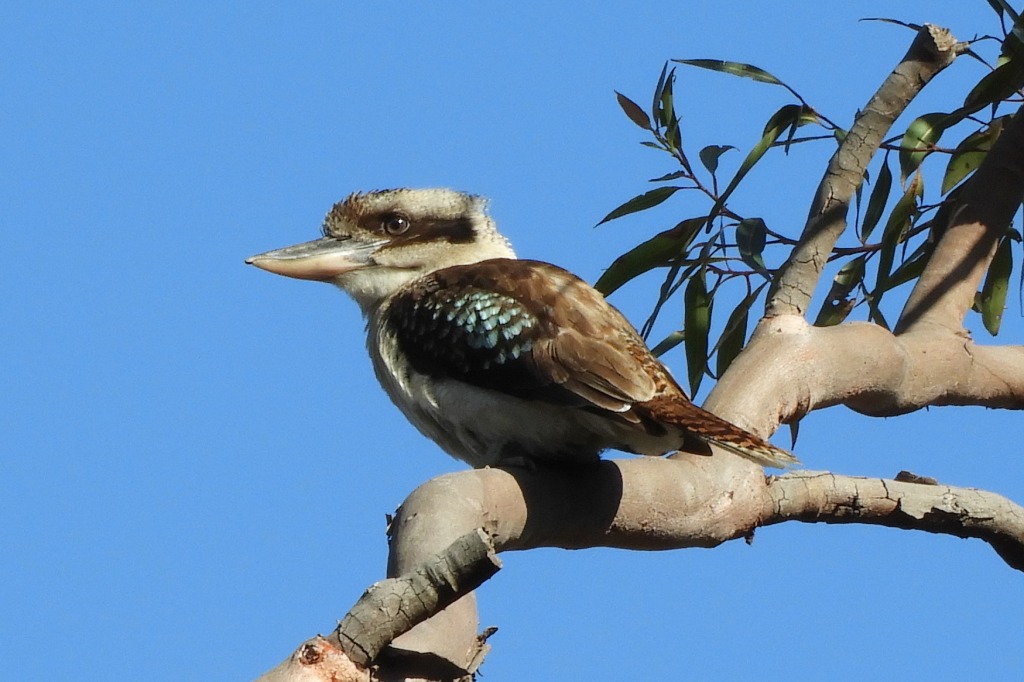
Juvenile Channel-billed Cuckoo and female Koel Cuckoo
Today an unearthly caterwauling called my attention to a juvenile Channel-billed Cuckoo perched on a wire. It was crouched down, flapping its wings, and uttering harsh calls:

Even at this age, it’s a big bird. I’d guess it was already full size, at around 60 centimetres in length. A giant baby indeed. And one that needs a lot of feeding.
The youngster stretched out its neck and called even louder:

It peered up into the air expectantly:

I didn’t catch any pictures of the next stage, alas, because the bird flew to a leafy tree and was mostly hidden from view. I did see the dedicated proxy parent, a Currawong, feeding the youngster, accompanied by a frenzied gabbling noise from the demanding child.
Common name: Channel-billed Cuckoo
Scientific name: Scythrops novaehollandiae
Approximate length: 58-65 cm
Date spotted: 23 January 2021 (summer)
Location: Manly Dam Park, New South Wales, Australia: 33°46’06.4″S 151°14’52.6″E
In a nearby tree, a female Koel Cuckoo sat and watched the commotion:

Common name: Common Koel or Eastern Koel
Scientific name: Eudynamys scolopacea
Approximate length: 45 cm
Date spotted: 23 January 2021 (summer)
Location: Manly Dam Park, New South Wales, Australia: 33°46’06.4″S 151°14’52.6″E
Both Channel-billed and Koel cuckoos are parasitic cuckoos, which means that they lay their eggs in the nests of other birds, and leave it up to those other birds to feed and care for the youngsters. Bot cuckoo types are migratory, coming down to this part of Australia for the warmer summer months, then heading to more northern countries for the winter.
Want to know more? I’ve posted some pictures and stories about previous encounters with cuckoos.









